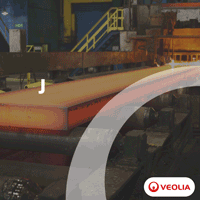New Off-Gas Analysis System from MORE Put Into Operation at Gerdau Jacksonville
11/18/2013 - In August 2013, MORE srl of Gemona del Friuli, Italy, installed and commissioned a new generation LINDARC 2.0 real time laser EAF off-gas analysis system at Gerdau Jacksonville.
The installation was part of a technological upgrading of previous equipment which has been in operation since 2010.
Even though the original system was generating savings combined with minimum maintenance operations and reliable water leak detection software in service; due to the constant development of lasers technology, new and more powerful hardware was available and the original laser system has been upgraded with the new 2.0 generation.
The Gerdau Jacksonville melt shop has a capacity to produce over 1 million tonnes of rebar and wire rod products each year. It operates a 90 tonne (99 ton) EAF which is equipped with a 90 MVA transformer and ‘Module Technology’ chemical energy package.
The LINDARC 2.0 technology, with lasers installed on the mobile duct, just after the secondary gap, uses the technique of “tunable diode laser absorption spectroscopy” (TDLAS); it performs real-time off-gas emissions measurements of CO, CO2, H2O and fume temperature with precise and quick results (less than 2 seconds compared to more than 30 seconds of traditional extraction systems) even with a very high dust content and high temperature in the off gases. The measurements are made on the real off-gas volume, no sampling, drying or filtering needed as with the extractive systems. The sturdy design and high quality manufacturing equipment, allows to operate with a technology that no require regular maintenance operation thus generates substantial savings compared with traditional extractive systems. LINDARC 2.0 maintenance operation can be summarized with a monthly visual inspection of the cleanliness of laser lenses (only 20 minutes of work during a scheduled shut-down maintenance day and no parts have been removed/replaced). At Gerdau Jacksonville no main maintenance operations have been performed on the lasers equipment for more than 36 months.
A dedicated closed-loop-control system operates for a dynamic and automatic management of the chemical energy package, dedicated post-combustors are installed to perform CO and H2 combustion into the EAF furnace shell to transfer the generated exothermic energy on the scrap pile.
The LINDARC 2.0 includes a new release of the Dynamic Water Leak Detection software to prevent any dangerous explosion generated by incidental water leak that may occur during operations. Using a specific proprietary software algorithm, that considers several variables and environmental conditions, it is possible to calculate and plot an expected water baseline level for every heat; any incidental water leak that may occur, will increase the water content above the dynamically/self-calculating baseline level and generate a warning message for the operators. Since the installation in 2010, the system has demonstrated reliability and precision to detect water leakages.
The new LINDARC 2.0 system is proving its reliability resulting in limited maintenance operation, optimization of EAF process with subsequent transformation costs reduction and a precise system to detect incidental water leaks to prevent dangerous explosion.
Even though the original system was generating savings combined with minimum maintenance operations and reliable water leak detection software in service; due to the constant development of lasers technology, new and more powerful hardware was available and the original laser system has been upgraded with the new 2.0 generation.
The Gerdau Jacksonville melt shop has a capacity to produce over 1 million tonnes of rebar and wire rod products each year. It operates a 90 tonne (99 ton) EAF which is equipped with a 90 MVA transformer and ‘Module Technology’ chemical energy package.
The LINDARC 2.0 technology, with lasers installed on the mobile duct, just after the secondary gap, uses the technique of “tunable diode laser absorption spectroscopy” (TDLAS); it performs real-time off-gas emissions measurements of CO, CO2, H2O and fume temperature with precise and quick results (less than 2 seconds compared to more than 30 seconds of traditional extraction systems) even with a very high dust content and high temperature in the off gases. The measurements are made on the real off-gas volume, no sampling, drying or filtering needed as with the extractive systems. The sturdy design and high quality manufacturing equipment, allows to operate with a technology that no require regular maintenance operation thus generates substantial savings compared with traditional extractive systems. LINDARC 2.0 maintenance operation can be summarized with a monthly visual inspection of the cleanliness of laser lenses (only 20 minutes of work during a scheduled shut-down maintenance day and no parts have been removed/replaced). At Gerdau Jacksonville no main maintenance operations have been performed on the lasers equipment for more than 36 months.
A dedicated closed-loop-control system operates for a dynamic and automatic management of the chemical energy package, dedicated post-combustors are installed to perform CO and H2 combustion into the EAF furnace shell to transfer the generated exothermic energy on the scrap pile.
The LINDARC 2.0 includes a new release of the Dynamic Water Leak Detection software to prevent any dangerous explosion generated by incidental water leak that may occur during operations. Using a specific proprietary software algorithm, that considers several variables and environmental conditions, it is possible to calculate and plot an expected water baseline level for every heat; any incidental water leak that may occur, will increase the water content above the dynamically/self-calculating baseline level and generate a warning message for the operators. Since the installation in 2010, the system has demonstrated reliability and precision to detect water leakages.
The new LINDARC 2.0 system is proving its reliability resulting in limited maintenance operation, optimization of EAF process with subsequent transformation costs reduction and a precise system to detect incidental water leaks to prevent dangerous explosion.



-(220-x-200-px)-(130-x-130-px)-(220-x-200-px).jpg?lang=en-US&ext=.jpg)
.gif?width=200&height=200&mediaprotectionhash=ddb07947ad3b4ab959a83714461eccd5c6895f370695eb035a9ff7aa736f8ad9&ext=.gif)





